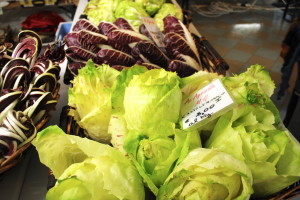
Radicchio is like a religion in the province of Treviso, where I live. Called the “winter flower” because the traditional five month growing season is from November to March, it’s found absolutely everywhere. There are always local festivals, fairs and events (this year there are 11) based around this beautiful vegetable. The red radicchio of Treviso, cleverly called Radicchio Trevisano and resembles a large Belgian endive, has an IGP (Indicazione Geografica Protteta) designation which certifies that it’s been produced in a manner consistent with the qualities established by the government.
Other types of Italian radicchio are Tardivo (meaning late),

 Precoce (early as it’s sowed in July)…
Precoce (early as it’s sowed in July)…
And the light green Castelfranco variety which dates back to the 9th century.

And we don’t want to forget about Galileo, Verona and Lusia while the most common variety grown in the United States is Chioggia, which is round, maroon and about the size of a grapefruit.




Radicchio is technically a type of chicory with a slightly bitter flavor and we eat it in a variety of ways – grilled with olive oil, in risotto, pasta or raw in salads. Some local bakeries have started making radicchio tarts which will surprise you for the excellent combination of the bitter taste of the radicchio and the sweet taste of the sugar.
A local poet, Giovanni Rizzi, wrote the following poem (which rhymes in Italian) and is considered the Radicchio anthem.
Se lo guardi, egli è un sorriso (If you look at it, it is a smile)
Se lo mangi è un paradiso (If you eat it it is a paradise)
…il Radicchio di Treviso (The Radicchio of Treviso)












